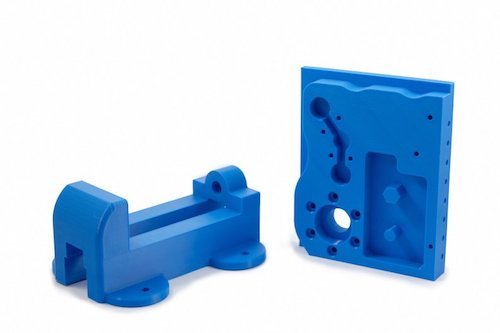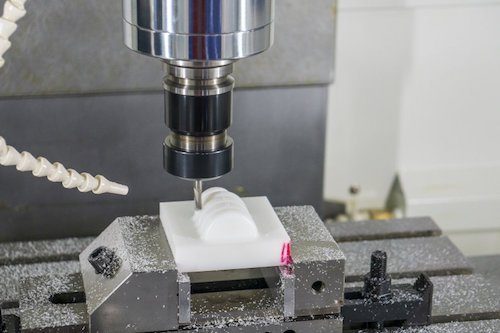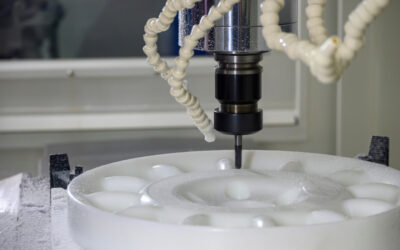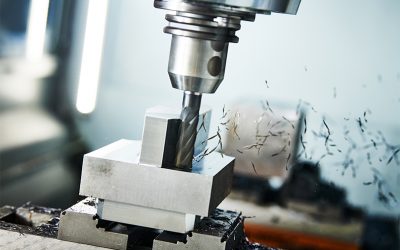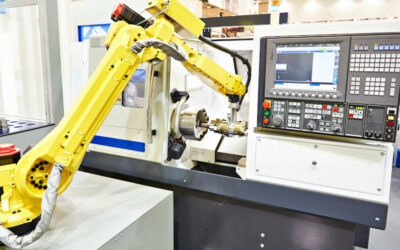CNC machining is a versatile and efficient process that countless companies use to produce their pieces and parts. This high-precision, high-quality, and fast-paced production process can accommodate a wide range of different materials.
Metals, woods, composites, and plastics are all suitable for machining, and among them, plastics are one of the most common. But there are many types of machinable plastics, so how do you choose the right one?
It’s not an easy question to answer, and it depends on a range of different factors. This article will explain the properties you have to keep in mind while working with plastics and give examples of the most common plastics used.
4 Factors to Consider When Choosing a Plastic
As we explained in our article about CNC machining materials, the physical properties of a material affect its machinability. As such, the results you can obtain from your workpiece will vary by material.
With plastics, the size and shape of your workpiece can change during or even after machining. As such, design engineers need to take material properties into account to ensure the manufacturability of their design. Next, we’ll explain the various factors you should consider.
#1 Thermal Expansion and Heat Deflection Temperature (HDT)
Almost every material expands and gains volume at high temperatures. In CNC machining, the tooling used produces heat when it contacts the material.
In the case of plastics, their coefficient of thermal expansion is higher than metals. As such, they can exhibit a more significant change in size as a result of machining.
Therefore, it is crucial to understand how each plastic reacts to heat input from machining. You should also consider the amount of heat exposure the plastic will receive. These factors will impact the ability to meet dimensional tolerances.
Additionally, a material’s heat deflection temperature (HDT) indicates when it will start to deform easily due to exposure to elevated temperatures. When making your final materials selection, you may need to consider this to ensure the part is suitable for its intended application.
#2 Hardness and Strength
The hardness and strength properties of a specific plastic may be something you are considering for your part to make sure it stands up to the requirements of its final application. However, these properties also affect the way a material behaves during machining.
The tensile strength of a material can impact how it forms chips, affecting the final surface finish. Hardness can also affect the way chips form, and for very soft materials, gouging can occur if the operator does not take suitable precautions.
Furthermore, the hardness and tensile strength of a material can impact the wear life of the tooling used. However, this is generally a more significant consideration when machining metals and ceramics.
#3 Moisture Absorption and Reaction to Chemicals
Certain plastics can absorb moisture from the air or coolant or can be detrimentally affected by certain chemicals. They may even need to be kept in air-conditioned rooms or sealed bags.
The effects of moisture and chemicals can cause the dimensions of the material to change, affecting the ability to meet precise tolerances. They can even degrade the strength and stability of the plastics altogether.
#4 Appearance, Transparency, and Light Transmittance
Appearance and associated properties, such as light transmittance, may be an essential aspect of your design. If so, this limits the number of plastic materials available to you. Furthermore, care will need to be taken with the machining process to ensure a rough surface finish does not impact light transmittance or transparency.
Top 10 Plastics Used in CNC Machining
Based on the factors described above, you may be wondering which machinable plastics are best and how to apply those factors to which plastic you should use for your project?
Luckily there are plenty of applications for CNC machined plastics, including in medicine, automotive, aerospace, electronics, clothing, technology, and even building construction! In the table below, you’ll find 10 of the best machinable plastics:
| Name | Chemical Name | Description | Advantages | Disadvantages | Applications |
|---|---|---|---|---|---|
| ABS | Acrylonitrile Butadiene Styrene | A Terpolymer made by polymerizing styrene and acrylonitrile. | Thermal and chemical stability and good strength. | Can be harmful if heated to above 400ºC. | Control panels, pipes, keyboards, etc. |
| Acetal/POM | Polyoxymethylene | A thermoplastic that is highly suitable for producing high hardness precision parts. | Low moisture sensitivity, high resistance to chemicals, good electrical resistivity, high hardness. | Sensitive to acid hydrolysis and oxidation by chlorine. | Mechanical gears, screws, bobbins, telephones, televisions, etc. |
| Acrylic/PMMA | Poly(methyl methacrylate) | A transparent thermoplastic. | Transparency, tensile and flexural strength. | Poor impact resistance, limited heat resistance, and low chemical resistance. | Light lenses, intraocular lenses, artificial teeth, etc. |
| Nylon/PA | Polyamides | A silk-like thermoplastic, it can be melt-processed into a variety of shapes. | Good elasticity, can be washable and dyeable, and resists high levels of heat. | Low absorbency, pollution problems, lack of stability. | Washers, gaskets, wheels, wear-resistant barriers, etc. |
| PC/Polycarbonate | Polycarbonate | Group of thermoplastics that can produce durable materials with high-impact resistance. | Good stiffness, highly transparent, and good thermal resistance. | Low scratch resistance and can expand. | Electronics, roofing sheets, compact disks, automotive and aircraft parts, etc. |
| PEEK | Polyether ether ketone | A semicrystalline organic thermoplastic, useful in several advanced engineering applications. | Very good strength, heat resistance, and chemical resistance. | Expensive relative to other plastics, and with poor UV light resistance. | Aerospace and automotive components, pumps, bearings, medical implants, etc. |
| PET | Polyethylene terephthalate | A colorless and semi-crystalline thermoplastic polymer resin. It can be semi-rigid or rigid, and is also very lightweight. | Good strength and stiffness, low moisture sensitivity, fully recyclable. | Thermal sensitive, fair HDT, fair moldability. | Soft drinks bottles, solar cells, frozen food trays, magnetic tapes, etc. |
| PVC | Polyvinyl chloride | A synthetic plastic polymer available in a rigid form (RPVC) or flexible form. | Good mechanical strength and toughness, and good chemical resistance. | Poor heat stability, can emit toxic fumes when melted or exposed to fire. | Window frames, drainage/water pipes and valve components, etc. |
| HDPE | High-density polyethylene | Thermoplastic polymer produced from ethylene. | High strength and stiffness, low moisture absorption, and good chemical corrosion resistance. | Sensitive to stress cracking, sensitive to oxidizing acids, high thermal expansion, and highly flammable. | Chemical tanks, cutting boards for food preparation, orthotics and prosthetics, etc. |
| FEP | Fluorinated ethylene propylene | Copolymer similar to PTFE and PFA resins. FEP is highly transparent and resistant to sunlight. | Low coefficient to friction, good stress crack resistance, and chemical resistance to a wide range of solvents. | Very sensitive to stress and limited strength. | Chemical equipment, food processing equipment, and various low friction parts. |
There are many other machinable plastics, so inquire with our service experts if you want to use a different material!
Which Plastic Should You Choose for Your CNC Project?
As you may have realized, there is a wide variety of CNC machinable plastics available. But, which is best for your project?
If you are looking for a strong plastic with transparency properties, you may want to choose between PC, Acrylic, or PET, though you should keep in mind their thermal limitations.
Maybe you need something with good chemical resistance? If so, CNC machining your product from ABS, PEEK, POM, PVC, HDPE, or FEP may be an excellent option.
It really depends on your goals for the part. And if you want assistance deciding which material is best for your application, our experts can provide insightful advice for you to make sure your project turns out just right!

